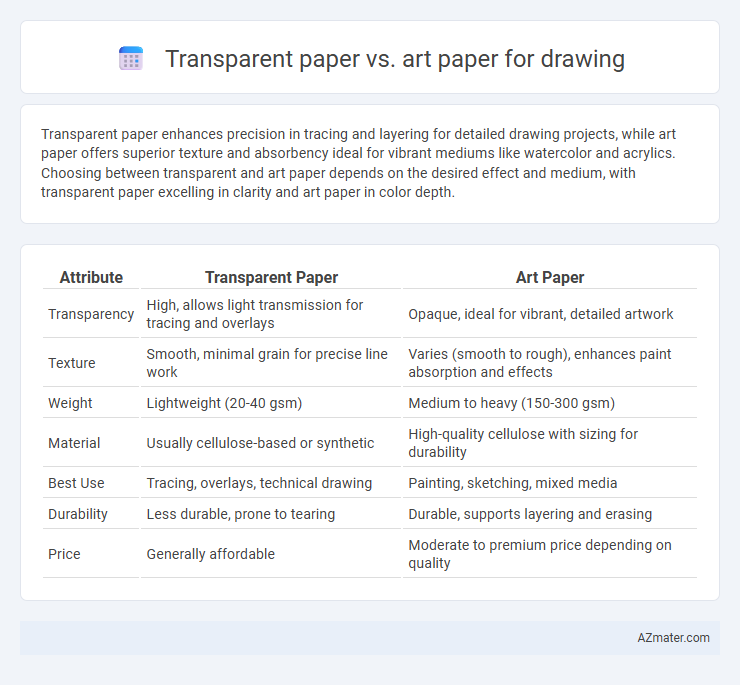Transparent paper enhances precision in tracing and layering for detailed drawing projects, while art paper offers superior texture and absorbency ideal for vibrant mediums like watercolor and acrylics. Choosing between transparent and art paper depends on the desired effect and medium, with transparent paper excelling in clarity and art paper in color depth.
Table of Comparison
| Attribute | Transparent Paper | Art Paper |
|---|---|---|
| Transparency | High, allows light transmission for tracing and overlays | Opaque, ideal for vibrant, detailed artwork |
| Texture | Smooth, minimal grain for precise line work | Varies (smooth to rough), enhances paint absorption and effects |
| Weight | Lightweight (20-40 gsm) | Medium to heavy (150-300 gsm) |
| Material | Usually cellulose-based or synthetic | High-quality cellulose with sizing for durability |
| Best Use | Tracing, overlays, technical drawing | Painting, sketching, mixed media |
| Durability | Less durable, prone to tearing | Durable, supports layering and erasing |
| Price | Generally affordable | Moderate to premium price depending on quality |
Introduction to Transparent Paper and Art Paper
Transparent paper is a lightweight, semi-transparent material ideal for tracing and layering techniques in drawing, allowing artists to refine sketches and transfer designs with precision. Art paper, typically thicker and textured, provides a durable surface suited for a variety of media including pencil, ink, and watercolor, enhancing the vibrancy and detail of artwork. Choosing between transparent paper and art paper depends on the specific drawing technique and desired visual effect, with transparent paper excelling in detail refinement and art paper offering versatility and rich texture.
Key Characteristics of Transparent Paper
Transparent paper features a smooth, translucent surface that allows artists to trace and layer drawings with precision, making it ideal for preliminary sketches and overlays. Its lightweight composition offers excellent light transmission, enhancing visibility of underlying images, which supports detailed work and iterative design processes. Unlike art paper, transparent paper has minimal texture and absorbency, preventing ink bleeding and maintaining sharp line quality essential for technical and fine art applications.
Key Characteristics of Art Paper
Art paper features a smooth or textured surface designed to hold graphite, charcoal, and colored pencils effectively, providing excellent durability and resistance to smudging. Its thicker weight and acid-free composition ensure longevity and prevent deterioration over time, making it ideal for detailed drawings and mixed media applications. The paper's archival quality supports vibrant color retention and fine detail reproduction, distinguishing it from thin, translucent transparent paper typically used for tracing.
Surface Texture Comparison
Transparent paper features a smooth, non-absorbent surface ideal for tracing and layering, allowing precise line work without ink spreading. Art paper usually has a textured surface like cold-pressed or rough finishes that enhance grip for pencils, charcoals, and pastels, adding depth and richness to drawings. The choice between transparent and art paper depends on the desired effect, with transparent paper offering clarity and art paper providing tactile interaction with drawing media.
Ink and Pencil Compatibility
Transparent paper offers superior ink compatibility due to its smooth surface that prevents bleeding and feathering, making it ideal for precise ink drawings. Art paper, with its textured finish, absorbs pencil graphite well, allowing for rich shading and detailed pencil work but may cause ink to spread unevenly. Choosing between transparent and art paper depends on the medium, as transparent paper excels with ink, while art paper favors pencil compatibility.
Suitability for Layering and Tracing
Transparent paper offers exceptional suitability for layering and tracing due to its translucency, allowing artists to easily see underlying sketches and make precise adjustments without damaging original work. Art paper, while generally thicker and more textured, provides better durability for final drawings but lacks the transparency needed for effective tracing and layering. For techniques requiring multiple layers and detailed replication, transparent paper remains the preferred medium, enhancing workflow and accuracy in artistic projects.
Color Vibrancy and Absorption
Transparent paper offers moderate color absorption, allowing inks and markers to sit on the surface and maintain high color vibrancy, ideal for vibrant overlays and tracing. Art paper, often thicker and more textured, absorbs pigments deeper, resulting in richer, more saturated colors but with slightly less brightness. Choosing between transparent and art paper depends on the desired balance between sharp vibrancy and deep pigment absorption for specific drawing techniques.
Durability and Longevity
Transparent paper, often used for tracing and overlays, features a smooth surface but lacks the durability and longevity of art paper due to its thinness and susceptibility to tearing and yellowing over time. Art paper, specifically designed for drawing, is thicker and acid-free, offering superior resistance to wear, fading, and environmental damage, which ensures the preservation of artwork for decades. Artists seeking longevity and archival quality prioritize heavyweight, textured art paper over transparent options to maintain the integrity of their drawings.
Best Use Cases for Drawing
Transparent paper, also known as tracing paper, is ideal for detailed sketch overlays, precise line work, and transferring images due to its semi-translucent quality. Art paper, including mediums like Bristol or textured drawing paper, offers superior durability and better absorption, making it perfect for mixed media, graphite, charcoal, and ink drawings requiring rich textures and shading. Choosing between transparent and art paper depends on whether the artist prioritizes image transfer and layering or robust surface qualities for detailed, finished artworks.
Choosing the Right Paper for Your Art Style
Transparent paper offers a smooth surface ideal for detailed line work, tracing, and layering techniques, making it perfect for artists who prioritize precision and lightbox use. Art paper, typically textured and thicker, enhances the depth and richness of mediums like charcoal, pastels, and watercolor, supporting more expressive and textured styles. Selecting the right paper depends on your preferred medium and artistic approach, with transparent paper favoring fine detail and layering, while art paper suits bold, tactile applications.

Infographic: Transparent paper vs Art paper for Drawing
 azmater.com
azmater.com